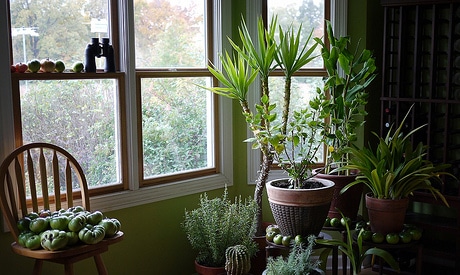
Said the houseplant to the wood floor: “We’re both pretty, but you just lie around all day while I’m busy cleaning the air.” If houseplants could talk – and floors had ears, this would totally be a true story, right?
Let me start by saying that I would love for the answer to be yes. I’ve been nurturing five lovely houseplants in my home for the past seven years under the assumption that my houseplants not only make my home look more attractive, but they also act as a natural form of air filtration through their follicular and root-system absorption of airborne pollutants.
Unfortunately, it’s not as simple as it sound. It’s not that houseplants don’t have the capacity to filter the air of pollutants. In fact, the United States Environmental Protection Agency has stated that in laboratory settings, certain houseplants have been shown to reduce the level of airborne pollutants. However, they have also made clear that there is currently “no evidence” that a “reasonable number” of houseplants are capable of removing “significant quantities of pollutants in homes and offices.”
Read more about living green
Research supports the notion that certain houseplants have the ability to remove indoor air contaminants such as VOCs (volatile organic chemicals emitted from synthetic carpeting, upholstery, fabrics and other manmade materials such as pressed wood and plastics, computers and other electronics, airborne microbes and allergens, and even the chemical products of human and animal respiration). They may also remove airborne cooking byproducts, pet dander, pollutants brought in from the outside via shoes and clothing, and emissions from household cleaning products, temperature management systems and even perfumes, candles and air fresheners.
However the number of houseplants necessary to make a “significant” impact on indoor air quality is not likely to be a number that most households or offices can accommodate: that number has been estimated to be somewhere around two houseplants (in 10 to 12-inch non-synthetic pots) per 100 square feet of indoor space.
Of course, only you can decide whether you are willing to purchase and nurture approximately 20 houseplants in a 1,000 square foot apartment or 50 houseplants in a 2500 square foot house. On the other hand, it doesn’t have to be an all-or-nothing proposition. You can have a “reasonable” number of carefully-curated houseplants (among the best air-purifying choices: peace lily, dracaena marginata, lady palm, spider plant, snake plant, rubber plant and weeping fig) and also take other measures to improve air quality. The EPA recommends these three key measures"
1. Eliminate sources of pollution, or contain them where possible: easily eliminated sources include open paint cans, old carpeting, furniture and electronics devices.
2. Improve ventilation: install/make use of exhaust fans, doing emission-producing activities outside when possible (for example – cooking, painting, sanding, welding, smoking).
3. Invest in an air-cleaner, which are generally designed to remove particles, as opposed to gaseous pollution, from the air. In this way, they can supplement the hard work your plants are doing.




